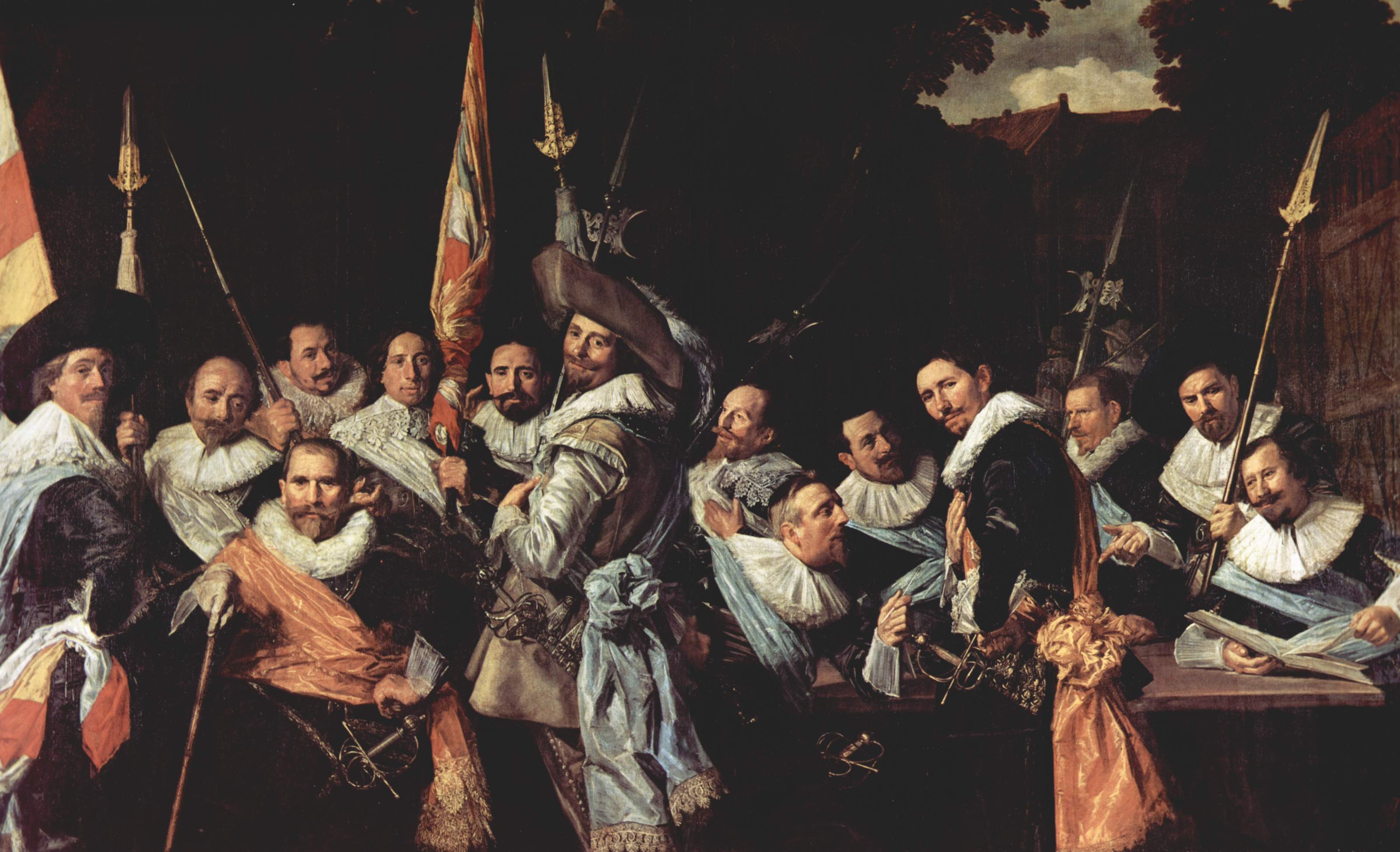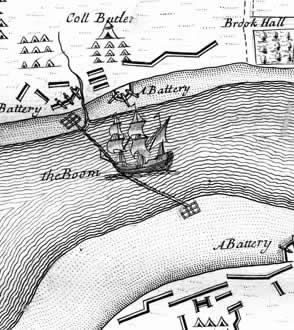|
Damiaatjes
The Damiaatjes (English: Little Damiettas) refer to two bells in the St. Bavochurch of Haarlem that ring every night between nine and nine thirty, to signal the closing of the city's gates and commemorate the conquest of the Egyptian city Damietta during the Siege of Damietta (1218). Though Haarlem no longer has a wall around the city, or gates to close, the bells are still rung every evening. Damietta is also mentioned during the Fifth Crusade in 1218/1219, and again during the Seventh crusade in the year 1249. The Haarlem story claims that Haarlem knights and innovative shipbuilders played an important role in the fall of Damietta. Access to the city via the Nile was closed with a large, heavy harbor chain. A Haarlem ship with a saw on the bow (in Dutch called the "zaagschip") was equipped with an iron saw fastened along the bow and front keel. This ship sawed through the Damietta harbour chain and allowed the fleet to attack the city, which was a success. The Damietta story ... [...More Info...] [...Related Items...] OR: [Wikipedia] [Google] [Baidu] |
Haarlem City Hall
The City Hall in Haarlem is the seat of the city's government. It was built in the 14th century replacing the Count's castle. History Around 1100 a wooden building was constructed on the location of the current ''Gravenzaal'' of the City Hall. Traces of this building were found in 1955. After large fires in 1347 and 1351,William I, Duke of Bavaria who was also the Count of Holland at that time, donated the remains of the Gravenzaal to the city's municipality. A new building was built there. The central square building dates from the Middle Ages, but the distinctive façade of the building was designed by architect Lieven de Key and built from 1602-1604. The way it originally looked can be seen in a painting from 1460 by the Master of Bellaert. Originally the city hall was just the front of the building, and the rear cloister belonged to the Dominican brotherhood. After the Protestant Reformation this came into the possession of the city council and it is now a large complex wit ... [...More Info...] [...Related Items...] OR: [Wikipedia] [Google] [Baidu] |
Pieter Holsteyn I
Pieter Holsteyn (1585–1662) was a Dutch Golden Age painter, engraver and stained glass worker. Biography Holsteyn was born and died in Haarlem. According to Houbraken who quotes Samuel Ampzing, "Pet. Holstein" was a good glasspainter who painted the damiaatjes in the Haarlem City Hall council chamber ("vroedschapskamer")".Pieter Holsteyn mentioned in ''De groote schouburgh der Nederlantsche konstschilders en schilderessen'' (1718) by , courtesy of the Digital library for Dutch literature
[...More Info...] [...Related Items...] OR: [Wikipedia] [Google] [Baidu] |
Damietta
Damietta ( arz, دمياط ' ; cop, ⲧⲁⲙⲓⲁϯ, Tamiati) is a port city and the capital of the Damietta Governorate in Egypt, a former bishopric and present multiple Catholic titular see. It is located at the Damietta branch, an eastern distributary of the Nile Delta, from the Mediterranean Sea, about north of Cairo. Damietta joined the UNESCO Global Network of Learning Cities. Etymology The modern name of the town comes from its Coptic name Tamiati ( cop, ⲧⲁⲙⲓⲁϯ} Late Coptic: ), which in turn most likely comes from Ancient Egyptian ("harbour, port"), although al-Maqrizi suggested a Syriac etymology. History Mentioned by the 6th-century geographer Stephanus Byzantius, it was called ''Tamiathis'' () in the Hellenistic period. Under Caliph Omar (579–644), the Arabs took the town and successfully resisted the attempts by the Byzantine Empire to recover it, especially in 739, 821, 921 and 968. The Abbasids used Alexandria, Damietta, Aden and Siraf ... [...More Info...] [...Related Items...] OR: [Wikipedia] [Google] [Baidu] |
Cornelis Claesz Van Wieringen
Cornelis Claesz van Wieringen (c. 1576 – 29 December 1633) was a Dutch Golden Age painter. Biography Van Wieringen was born and died in Haarlem. He was the son of a Haarlem captain, and drew, painted and etched with his friends Hendrick Goltzius and Cornelis van Haarlem. He also held important positions in the Haarlem Guild of St. Luke, the painters' guild, where he became a member in 1597. in the He specialized in paintings depicting ships and sea battles, and received orders from the municipal councils of Haarlem and . He painted the most popular picture of the ... [...More Info...] [...Related Items...] OR: [Wikipedia] [Google] [Baidu] |
Raid On The Medway
The Raid on the Medway, during the Second Anglo-Dutch War in June 1667, was a successful attack conducted by the Dutch navy on English warships laid up in the fleet anchorages off Chatham Dockyard and Gillingham in the county of Kent. At the time, the fortress of Upnor Castle and a barrier chain called the "Gillingham Line" were supposed to protect the English ships. The Dutch, under nominal command of Willem Joseph van Ghent and Lieutenant-Admiral Michiel de Ruyter, over several days bombarded and captured the town of Sheerness, sailed up the Thames estuary to Gravesend, then sailed into the River Medway to Chatham and Gillingham, where they engaged fortifications with cannon fire, burned or captured three capital ships and ten more ships of the line, and captured and towed away the flagship of the English fleet, . Politically, the raid was disastrous for King Charles' war plans and led to a quick end to the war and a favourable peace for the Dutch. It was one of the worst ... [...More Info...] [...Related Items...] OR: [Wikipedia] [Google] [Baidu] |
Frans Hals Museum
The Frans Hals Museum is a museum located in Haarlem, the Netherlands. The museum was established in 1862. In 1950, the museum was split in two locations when the collection of modern art was moved to the '' Museum De Hallen'' (since 2018 called ''Hal)''. The main collection, including its famous 17th-century Frans Hals paintings, for which the museum is named, is located in the former ''Oude Mannenhuis'' on the Groot Heiligland. The museum was founded in 1862 in the newly renovated former Dominican church cloisters located in the back of the Haarlem city hall known as the ''Prinsenhof'', and when it needed more space, it moved to the recently vacated location of the town orphanage in 1913. The collection is based on the large number of paintings owned by the City of Haarlem, which includes over 100 artworks seized from Catholic churches in the 1580s after the Protestant Reformation, and Haarlem art rescued from demolished local buildings from the 15th century onwards. In 2018 t ... [...More Info...] [...Related Items...] OR: [Wikipedia] [Google] [Baidu] |
Janskerk (Gouda)
The Sint Janskerk in Gouda, the Netherlands, is a large Gothic church, known especially for its stained glass windows, for which it has been placed on the list of the top 100 Dutch monuments. History The church is dedicated to John the Baptist, the patron saint of Gouda, and was built during the 15th and 16th centuries. In 1552 a large part of the church burned, including the archives. Most information of the early period is taken from the diaries of Ignatius Walvis. Around 1350 a tower was built (only the lower part remains). In 1485 the foundation was built for the present-day choir. This expansion made the church the longest in the Netherlands, with a length of 123 meters. The stained glass windows were made and installed primarily by the brothers Dirk and Wouter Crabeth I, in the years 1555-1571, and after a short stop for the Protestant Reformation, until 1603. During the Reformation the church was spared, because the city fathers sided with the reigning king Philip II of S ... [...More Info...] [...Related Items...] OR: [Wikipedia] [Google] [Baidu] |
Willem Thibaut
Willem Thibaut, Tybaut, or Tibout (1524–1597), was a Dutch Golden Age painter. Biography According to the RKD, Thibaut lived and worked in Haarlem, but made the cartoons for the two stained-glass windows in Sint Janskerk in 1570. According to Arnold Houbraken, who never understood why Karel van Mander never included glass painters in his ''Schilderboeck'', Thibaut was famous enough to be mentioned in Samuel Ampzing's praise of Haarlem with the words ''How masterly he could write on glass!''. Thibaut was also the inventor of the ''Counts of Holland'' print series that was later reprinted by Philip Galle and Michiel Vosmeer (1578–1616) in 1578 in Antwerp. This series of prints was published to accompany a reprint of Melis Stoke's ''Hollandse Jaar-Boeken of Rijm-Kronijk'' in 1699 by Cornelis van Alkemade. The addendum to the title; ''Met de Afbeeldingen van alle de HOLLANDSE GRAVEN, Geschetst naar de aaloude schilderijen der Karmeliten te Haarlem'' meant that the prints ... [...More Info...] [...Related Items...] OR: [Wikipedia] [Google] [Baidu] |
Bloemendaal
Bloemendaal () is a municipality and a town in the Netherlands, in the province of North Holland. Bloemendaal is, together with Wassenaar, the wealthiest place in the Netherlands. In October 2015, after persistent problems with the local governance in Bloemendaal, the King's Commissioner of North Holland, Johan Remkes, threatened to disband the municipality if the problems were not resolved within a year. Bernt Schneiders, the mayor of Haarlem, was appointed as acting mayor of Bloemendaal. Population centres The municipality of Bloemendaal consists of the following cities, towns, villages and/or districts: Local government The municipal government of Bloemendaal consists of 19 seats, which as of 2018 are divided as follows: * VVD - 5 seats * CDA - 3 seats * GroenLinks - 3 seat * D66 - 3 seats * Hart van Bloemendaal - 2 seats * PvdA - 1 seat * Liberaal Bloemendaal - 1 seats * Vrijzinnig Democratisch Bloemendaal - 1 seat Railway connections Bloemendaal has a railway st ... [...More Info...] [...Related Items...] OR: [Wikipedia] [Google] [Baidu] |
Boom (navigational Barrier)
A boom or a chain (also boom defence, harbour chain, river chain, chain boom, boom chain or variants) is an obstacle strung across a navigable stretch of water to control or block navigation. In modern times they usually have civil uses, such as to prevent access to a dangerous river channel. But, especially historically, they have been used militarily, with the goal of denying access to an enemy's ships: a modern example is the anti-submarine net. Booms have also been used to force passing vessels to pay a toll. Description A boom generally floats on the surface, while a chain can be on the surface or below the water. A chain could be made to float with rafts, logs, ships or other wood, making the chain a boom as well. Historical uses Especially in medieval times, the end of a chain could be attached to a chain tower or boom tower. This allowed safe raising or lowering of the chain, as they were often heavily fortified. By raising or lowering a chain or boom, access could be s ... [...More Info...] [...Related Items...] OR: [Wikipedia] [Google] [Baidu] |
Nile
The Nile, , Bohairic , lg, Kiira , Nobiin language, Nobiin: Áman Dawū is a major north-flowing river in northeastern Africa. It flows into the Mediterranean Sea. The Nile is the longest river in Africa and has historically been considered the List of rivers by length, longest river in the world, though this has been contested by research suggesting that the Amazon River is slightly longer.Amazon Longer Than Nile River, Scientists Say Of the world's major rivers, the Nile is one of the smallest, as measured by annual flow in cubic metres of water. About long, its drainage basin covers eleven countries: the Democratic Republic of the Congo, Tanzania, Burundi, Rwanda, Uganda, Kenya, Ethiopia, Erit ... [...More Info...] [...Related Items...] OR: [Wikipedia] [Google] [Baidu] |








